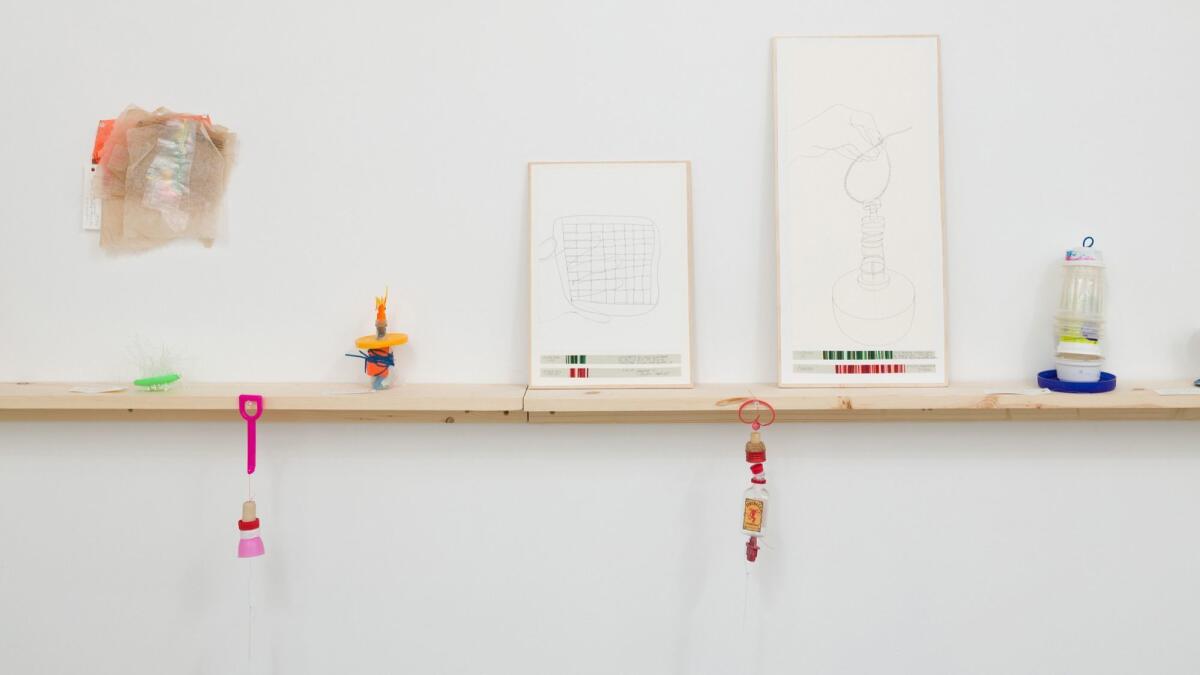Review: Lives on the line: How the art of Danica Phelps takes on environmental and humanitarian dimensions
- Share via
Danica Phelps draws with uncommon grace. Her line moves with liquid ease, following the momentum of time. It describes what happens in her life, and it also makes things happen. As her beautifully affirming show at Luis de Jesus Los Angeles gallery attests, her line has agency.
For more than two decades, Phelps, who divides her time between New York and Massachusetts, has been making drawings that chronicle her everyday experiences, annotated with visual tallies of her finances. At the bottom of a page, she typically affixes horizontal strips of paper densely painted with vertical stripes representing money earned and money spent, one green line per dollar taken in, one red line for every dollar going out. Sales of drawings are recorded within drawings, making for a regenerative circularity.

Everything from laundry to love-making has appeared in Phelps' work. Milestones, such as the buying or selling of a house, rub up against ordinary moments, so that implicit classifications of minor and major cease to hold; everything is significant, worth close observation and thoughtful inscription.
This wide-ranging endowment of humanistic value offsets the quantified value that Phelps also records — how much things sell for, how much the necessities and discretionary pleasures of life cost. The work quietly but persistently scratches at the conventional scales and common hierarchies of value.
In the Luis de Jesus show "Many Drops Fill a Bucket," everything still matters, and the artist's own identity remains the central organizing impulse of her visual archive, but the unfurling of her private world commands less attention than her commitment to the pressing needs of the planet.
The work here stems mostly from beach-cleaning trips she's taken to California and India, where she and her young son collected trash (mostly plastic) and turned some of it into tiny sculptures. A shelf of these playful, abject little stacks, dangles and weavings fills the back gallery, alternating with drawings of other such assemblages that have already been sold. All proceeds from these pieces go toward environmental and humanitarian nonprofits.

The other drawings made during these trips tenderly depict passing gestures or scenes: Phelps' son reading in a hammock; her hands cutting paper or closing the clasp of a necklace. Labor and leisure intermingle, as do neighboring moments, their contours merging like overlapping frames from a stop-motion film. As ever, Phelps's line is sensuous and pure, gorgeous as poetry.
W.H. Auden proposed in a poem that poetry makes nothing happen, but he countered with the decisive zinger that poetry is actually "a way of happening, a mouth." The same goes for Phelps' line, and there's money where that mouth is.
Luis de Jesus Los Angeles, 2685 S. La Cienega Blvd. Through Sept. 1; closed Sundays and Mondays. (310) 838-6000, www.luisdejesus.com

See all of our latest arts news and reviews at latimes.com/arts.
The biggest entertainment stories
Get our big stories about Hollywood, film, television, music, arts, culture and more right in your inbox as soon as they publish.
You may occasionally receive promotional content from the Los Angeles Times.







